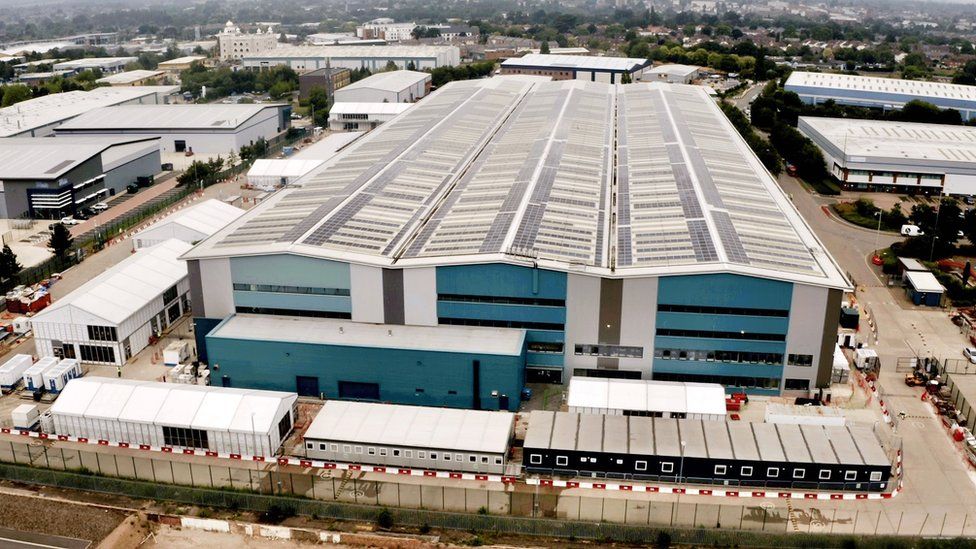Inside Britain’s flagship Covid lab that no one knows what to do with
With spiralling costs and issues around test processing, there are questions over the ability of the Rosalind Franklin Laboratory – once hailed as key to Britain’s fight against Covid-19 – to cope with the nation’s testing needs, writes Science Correspondent Samuel Lovett


Your support helps us to tell the story
From reproductive rights to climate change to Big Tech, The Independent is on the ground when the story is developing. Whether it's investigating the financials of Elon Musk's pro-Trump PAC or producing our latest documentary, 'The A Word', which shines a light on the American women fighting for reproductive rights, we know how important it is to parse out the facts from the messaging.
At such a critical moment in US history, we need reporters on the ground. Your donation allows us to keep sending journalists to speak to both sides of the story.
The Independent is trusted by Americans across the entire political spectrum. And unlike many other quality news outlets, we choose not to lock Americans out of our reporting and analysis with paywalls. We believe quality journalism should be available to everyone, paid for by those who can afford it.
Your support makes all the difference.It was hailed as a cutting-edge laboratory that would play a key role in response to Covid-19 and future epidemics, carrying out 300,000 tests a day.
Announcing the project in November 2020, then-health secretary Matt Hancock said the project “confirms the UK as a world leader in diagnostics”.
But less than 18 months later, the Rosalind Franklin Laboratory – named in honour of the renowned British scientist – has been plagued by failure while costing almost twice as much as its initial £588m budget, The Independent understands.
Instead of being at the forefront of the fight against Covid, the project opened six months late, facing a string of issues with equipment, staff and construction, with barely 20 per cent of its touted capacity being reached.
Now, as the government winds down its “lighthouse” testing labs as part of the plan to “live with Covid”, leaving the Leamington Spa facility as the last lab standing, there are questions about the future of the site – and whether it would be able to cope with the nation’s testing needs alone if another deadly wave of Covid were to emerge.
‘Massive pushbacks’
The project was announced as a flagship for the new UK Health Security Agency (UKHSA), which succeeded Public Health England as the body responsible for protecting the public from infectious diseases and oversees Covid testing in Britain.
The 220,000 square foot site, lauded as the largest testing facility of its kind in Europe, had been due to open the first of its processing lines in January 2021, the peak of the second wave of Covid-19. By June that year, nine out of 12 lines were to be functional.
However, it was not until 13 July that the laboratory was formally opened, with just a single line running. It was acknowledged that four of the lines would never be built, despite officials placing and receiving orders for testing equipment worth millions, sources involved in setting up the lab told The Independent.
“The Department for Health has said that was the plan all along. That absolutely was not the plan,” said an ex-senior scientist.

Insiders say construction delays also played a role, while attempts to avoid certifying equipment to speed up the process were stopped at the 11th hour, contributing to “massive pushbacks”. The UKHSA has said these claims are untrue.
Insiders believe these delays could have been avoided had the RFL recruited scientists and clinicians with the relevant experience from the beginning of the project, instead of relying on private consultants whose knowledge of working in the NHS was “almost non-existent”.
According to emails seen by The Independent, 31 lab support technicians were informed last summer – days before they were due to start work – that they would be paid to stay at home indefinitely due to delays, at a cost of tens of thousands of pounds to the taxpayer. A further 700 staff were on retainer last summer but had yet to begin work.
Staff “are all on short-term contracts,” said one senior scientist overseeing the UK’s Lighthouse Lab network. “That creates problems in running labs because if you’re on a short-term contract, and the longer-term job comes up, you’re naturally going to move on.”
‘Spiralling costs’
Its total budget was set at £588m, according to internal figures from June 2021. But by May that year, £500m had already been committed with costs “spiralling”, the former senior scientist said.
By November, the site was hundreds of millions of pounds over budget, according to another person familiar with the project’s finances. By February, estimates put the projected cost at £1.1bn, according to a Treasury source, who said costs were now out of hand. The UKHSA has said it does not recognise those numbers, pointing to figures provided to MPs from December that estimated expenditure to March this year at £426m.
In reality, government officials do not have a clear picture of how much has been spent on the project, according to the Treasury insider and a consultant involved in reviewing the lab’s future.
Prior to the opening of the site, when it became apparent that the RFL would not be built to its original intended size, procurement teams were pressured to break contracts with suppliers and “write off orders” for equipment worth hundreds of thousands of pounds, insiders say.
“We were told under no uncertain terms to never provide things like long-term equipment delivery schedules because that could be considered a promise to the supplier to honour the original arrangement in a court of law,” said the former senior scientist, who helped oversee procurement for the lab.
The Independent has been told that attempts were made by the Treasury to “pull the plug” on the project due to the spiralling costs, but was persuaded against it. The site is now “under review” by HMT officials. The Treasury declined to comment.
Professor Colin Fink, a medical director at the private diagnostics firm Microbiology, said: “The whole thing was too late, really. We could have done it for a tenth of the price … They didn't want us involved at all.”
‘Breaking constantly’
By October last year, the lab had processed its millionth Covid test. Under the government’s plans, it had been hoped the RFL would be working through 100,000 samples a day – revised down from 300,000. Instead, the lab was typically processing just 11,500, analysis suggests.
While this has risen in the months since, estimates from scientists put the average at 25,000 to 30,000 a day. The lab has never processed more than 65,000 tests in the space of 24 hours, 22 per cent of the initial projected capacity.
Sources say testing has been hindered by repeated mechanical malfunctions. A former lab worker questioned whether the machines, which are “very sophisticated and expensive”, were designed to run 24 hours a day.
“Some have been out of action at least once a week,” they said. Another source said “machines [were] breaking constantly, at a rate which should not happen”. A third said the mechanical issues occurred on a daily basis.
UKHSA has said equipment was routinely inspected and that multiple machines allowed testing to continue if one were to break.

If machines break during a night shift, staff are expected to call support teams in the US for to try to fix the equipment. “This is done via WhatsApp Video and can take two to three hours, during which time everything is put on hold,” which risked spoiled tests, one former senior member of staff in the lab said.
Concerns have also been raised that items used for the equipment, such as pipetting tips, are not compatible with the machines. This “means they are running outside of spec, so the manufacturers do not guarantee the validity of the results,” said a senior administrative source with oversight of the entire lab.
The former senior staff member said “tens of thousands” of tests had been redirected elsewhere in the government’s “lighthouse” network of private laboratories, including the Milton Keynes site, as a result of the repeated mechanical failings and lack of capacity.
Some 217,000 samples were diverted away from the lab between September last year and mid-March due to planned and unplanned circumstances, UKHSA said. This is “a safe and routine part of operations,” a spokesperson added.
But despite an awareness among staff that equipment regularly breaks, leading to the generation of invalid test results, such failures aren’t always reported to UKHSA, lab insiders say.
“There's a suspicion among some of the lab staff that these sorts of events … are to some extent routine,” said the senior administrative source, referencing sample contamination incidents that had “been brushed under the carpet”. UKHSA has said it does not recognise these claims.
In the vast majority of cases, incorrect results are identified by the lab’s quality control and evaluation teams, at which point the original sample is retested.
However, some false negatives and positives have slipped under the radar and were only retrospectively identified after the results had been returned to the public, according to three separate sources, including one with knowledge of the lab’s test verification system. UKHSA said it does not recognise these claims.
Last June, following a software update to the lab’s testing systems, around 1,900 samples were contaminated during processing and deemed invalid. After the issue was resolved, the affected members of the public were informed of the mistake and told to re-take their tests.
‘Sitting around’
Newcomers to the lab, many of whom are school leavers or university graduates, have little experience operating the types of machines used at the RFL and need to be taught how to use them. Yet the lab is “short of trainers” to do this, according to a former lab worker.
The senior administrative source said that junior staff are treated “quite poorly”, which “affects morale dramatically”, while a former worker said the site’s cleaning staff regularly sleep overnight in the RFL’s welfare area.
Workers say that their time at the lab has been characterised by intense pressure followed by shifts with very little to do. There have been examples of some staff working back-to-back 11-hour shifts; on other occasions, teams have been left “sitting around for 10 hours at a time” due to sample shortages. Staff have spent much of this time watching YouTube, playing video games, and even drinking on the site, multiple sources claim.
Read more special reports from our Supporter Programme
Despite the huge budget for the lab, workers say the site has been blighted by health and safety issues. Rats are said to have eaten through floor seals that close off the lab, while plumbing is also an issue, with leaking sinks and blocked toilets. “I've seen at least one occasion where an overflow of human effluent spilled out into one of the labs itself,” a former lab worker said.
Building work is ongoing, with parts of the site still being constructed and even rebuilt. Lab doors do not shut properly, light and ceiling fittings remain unfinished, and unused, expensive testing equipment has been left on site.
Earlier this year one builder sustained serious injuries and was rushed to hospital by air ambulance after falling through an opening in a wall that had been covered by a loose sheet. Balfour Beatty, which is responsible for construction, said “a person working for another contractor removed the protective safety barriers to gain access to a closed area, unauthorised, and an incident occurred”.
“The build of the laboratory is nearing completion,” according to UKHSA, while a spokesperson for Balfour Beatty said: “All works are regularly inspected by Building Control and each phase of works receives Building Control Acceptance as it is completed to the specified standard and quality.”
‘Everything’s being shut down’
Despite its shortcomings and limited capacity, the RFL is due to be established as the country’s main Covid testing site, with other, more efficient laboratories in the Lighthouse network being wound down.
“Once they decommission all these [other] laboratories, that's it,” said Professor Paul Klapper, who helped establish the Manchester Lighthouse lab. “If there’s a new wave… we'd be totally reliant on this single laboratory, which has not yet demonstrated it can actually run at very high capacity.”
“No one knows how to use” the RFL on a longer term basis, the consultant said, with the immediate focus fixed on recouping some of the site’s high costs.
The lab’s unused testing machines are seen as a potential means for making back money and avoiding excessive wastage. Officials have raised the possibility of relocating the equipment to other labs and different parts of the NHS. But the former senior scientist warned this “will be tricky” as the machines are sensitive, often large and “can’t just be put anywhere”.
There is talk, too, of cutting down the site’s 700-strong workforce and automating much of the testing procedures. “Operational costs are currently seen as too high, especially given the fact some staff are getting paid to do very little work,” the consultant said.
Although Covid testing services will remain the focus of the site, it’s hoped some of the unused space at the RFL will be dedicated to other health purposes. Genomic surveillance, national screening for cancer and the testing of other pathogens have been touted as possible options.
A UKHSA spokesperson said: “The Rosalind Franklin lab continues to play a critical role in the pandemic response, having already processed millions of tests to help stop the spread of Covid.
“There are strict protocols in place to protect all our staff and ensure they have the right training, with rigorous quality assurance in place to maintain the safety and accuracy of our equipment.
“As the public would expect, budgets and spend are tracked through a robust governance process and are reviewed regularly, to ensure the best possible value for the taxpayer.”
Despite its flaws, “the idea of the project is fundamentally sound,” the senior administrative source said. “I think if it were correctly managed, it could actually be a net positive for the country.”
Labour’s Matt Western, the MP for Warwick and Leamington, said he wanted the lab to become “an asset” for the local community, but insisted that “this involves openness, transparency and willingness to engage with the public, the media and elected officials”.
However, Prof Klapper suggested the lab might not be able to play an effective future role, in terms of both Covid and wider public health responses, given its shortcomings. “It hasn't yet proved that it is capable of doing what it says it can do, and everything is now being shut down around it,” he said.
Seeking to centralise Covid testing through the RFL, rather than maintaining a wider network that can be quickly mobilised and ramped up in response to future waves, creates risk, he added. “Because if that facility goes down, there's nothing to replace it.”
Join our commenting forum
Join thought-provoking conversations, follow other Independent readers and see their replies
Comments